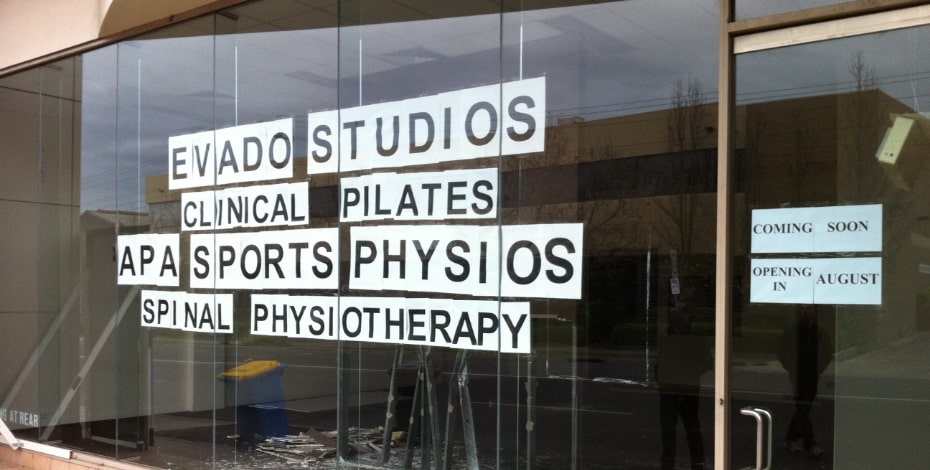
10 lessons from 10 years of practice

A decade ago, APA Sports and Exercise Physiotherapist Frank Care opened his first business venture, a physiotherapy practice in Melbourne. Here, the co-director of Evado Studios shares what he’s learned from running the private practice group during this period.
Around 20 per cent of small businesses fail within one year and just 30 per cent remain operational after 10 years.
These are sobering statistics and anyone making the life-changing decision to start a small business needs to understand that success is not guaranteed.
That said, there are upsides to running a successful business—the financial rewards and the role you play within your community.
Evado Studios started as a humble physiotherapy business in Hawthorn, Melbourne.
We had no significant capital behind us and our first week trading began with one Pilates reformer and a medical treatment bed.
By the end of the week, we had treated three patients and a four-metre-long mirror had fallen from the gym wall and shattered. Not the best start in the world of business.
We have endured ups and downs and are proud to have hit the 10-year mark.
Today, Evado Studios is a rehabilitation and fitness business with more than 100 staff across 15 sites.
Here are 10 things I’ve learnt along the way.
Listen to your customers
Customers are a valuable information resource for every small business.
One thing I realised early in my journey is that while I may think I have a great idea, it’s only great if my customers are willing to engage.
In the early days, the influence our customers had on Evado was profound.
Things such as what we offered, how we offered it and the way we branded ourselves all needed close
attention.
This helped deliver a better version of what we were doing and shaped the business into what it is today.
You need to drop your ego and be humble enough to listen and take on feedback, which is not dissimilar to how we wish our staff to behave.
Financial management is crucial
While we are in the business of helping others, understanding the numbers and appreciating the importance of financial management may be the difference between success and failure.
You may have a terrific team, a great marketing plan or a profound point of difference but none of this means anything if your business doesn’t stack up financially.
Key financial metrics that a small business needs to discover are its ‘break even’ point, revenue saturation figure, profitability at saturation and return on investment time frame and the amount of capital required to launch it.
While we might view financials as dry or boring, these figures are important.
Ask yourself, ‘Does my business idea make financial sense and is it worth pursuing?’
Making informed financial decisions can be tricky and employing the help of an accountant will give you peace of mind.
Staff first, customers second
We all know of the cliché ‘the customer is always right’ and of the importance of delivering exceptional service. But behind all happy customers are happy staff.
Staff form the backbone of any service-based business and successful business owners understand this concept.
If your staff are dedicated to the cause and happy with their working conditions, your customers will notice this and remain loyal to your business.
Creating a workplace environment that motivates staff to work hard and achieve results goes a long way towards building a sustainable business.
It also improves staff retention by galvanising teams through the creation of long-term working relationships.
Adaptability is necessary
Small businesses operate in a dynamic environment and face many challenges such as changes in market trends, regulations and technology.
It’s critical to have the ability to adapt to changes quickly and efficiently. COVID-19 certainly tested Evado.
While our mission ‘to give people the belief and confidence they can take their health to the next level’ remained unchanged, the way we delivered this mission had to adapt to and comply with the changing regulations.
Doing so meant we could continue trading as a business and, importantly, continue to communicate our mission clearly to our staff and patrons.
The power of marketing
Marketing needs to play a consistent role in delivering positive and meaningful messages to attract new clients.
It plays an equally important role in reminding past customers of your presence.
At Evado, we are always trying to keep our message simple so that we create a need for prospective customers to engage.
The ‘marketing mediums’ we use need to work together cohesively.

Frank Care.
For example, when promoting our brand, we think about how to best deliver a message ‘face to face’, ‘screen to screen’ and ‘ear to ear’.
A ‘face to face’ strategy can include things such as sporting club involvement or visiting local GPs.
A ‘screen to screen’ strategy might involve staff posting meaningful information on the website (ie, blogs) and
through social media.
An ‘ear to ear’ strategy may mean staff calling current or previous clients who have dropped off but have expressed a willingness to follow through with their rehab program.
Finally, it is essential that data is collected at Evado to help us understand how new clients found out about our brand. As with anything, you can’t manage what you can’t measure.
Planning, planning, planning
‘Am I spending too much time working in the business rather than on the business?’
Make sure you have a business plan that covers various aspects of finance, marketing, staffing and general operations.
If you don’t have a business plan, there’s plenty of reference material online to help you make a start.
Once you have established a plan, block out time in your diary where your attention is spent thinking about and executing the various tasks associated with these four areas.
This needs to be done consistently week to week so that you develop a routine that is second nature.
Break the cycle of ‘working in the business’ and put time aside to ‘work on your business’.
Hiring the right people
Jim Collins’ book Good to Great is an essential read for anyone interested in being educated about business. In relation to staff hiring, you need the right staff if you wish your business to be successful.
To quote Collins’ book: ‘If you have the right people on the bus, the problem of how to motivate and manage people largely goes away.
'The right people don’t need to be tightly managed or fired up; they will be self-motivated by the inner drive to produce the best results and to be part of creating something great.
'[However,] if you have the wrong people, it doesn’t matter [how great your vision is]. Great vision without great people is irrelevant.’
Hiring the right people is one of the most difficult tasks any business owner will encounter.
You will pick some winners but you will also get your fair share of mismatches.
Understand the ‘common thread’ that keeps your team together and firing on all cylinders and attempt to hire people on that basis.
Delegate to improve productivity
Leaders understand that remaining constantly active or busy is not necessarily the key to accomplishment.
According to bestselling author John C. Maxwell, a leader looks at the big picture and ensures that their daily activity aligns closely with the values and priorities of their workplace.
It is important to assess your usual tasks and ask yourself, ‘What should I stop doing, what should I start doing and what should I keep doing?’
Disciplined action is not just about doing more and working harder. True discipline is the ability to know which tasks you need to stop doing. Remember to assess your workload and try applying the stop, start, keep principle.
Staff transparency
I have always been a firm believer in the importance of sharing information about business performance and future planning with staff.
Communicating candidly with staff goes a long way towards building long-lasting relationships. It helps explain to them why certain decisions are made and the actions required to execute a plan.
Getting staff on board with decisions and involved in the ‘back end’ of your business creates an opportunity for task delegation and improves time productivity as well as morale.
Understand the why
Understanding your purpose or why you exist is key in a competitive market. Start with why, by Simon Sinek, is a terrific reference book.
As Sinek outlines, the problem with many businesses is that when it comes to selling themselves, too many people start with what they do rather than why they do it.
To use the example of physiotherapy, everyone knows what a physiotherapist does.
However, very few company owners can clearly articulate why they do what they do.
In Sinek’s book, he goes on to explain that the why is all about a company finding its purpose, cause or belief. ‘Why does your company exist? Why do you get out of bed every morning? And why should anyone care?’
Finding and articulating your true purpose helps establish a strong point of difference from your competitors.
What we do is physiotherapy but why we do physiotherapy creates a much more powerful narrative.
Starting and running a small business is a challenging but rewarding journey.
How people define success is variable but to understand what success means to you, you must start with a plan.
Many spokes create a wheel and perhaps the various parts that make a business successful can be viewed the same way.
I have outlined 10 things that I believe form important ‘spokes’ in the wheel of momentum that is Evado.
We are still learning and making mistakes but we show up each day and make the best of every situation possible.
>>Frank Care APAM MACP is an APA Sports and Exercise Physiotherapist and a co-director of Evado Studios, which has practices in Victoria and New South Wales. Frank consults with other physiotherapists who aspire to start their own practices.
© Copyright 2024 by Australian Physiotherapy Association. All rights reserved.





